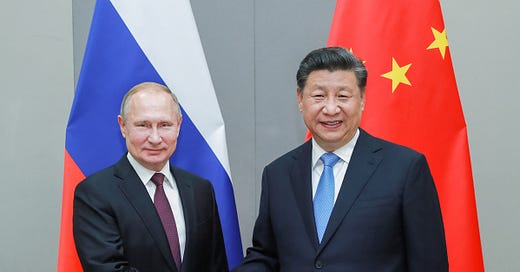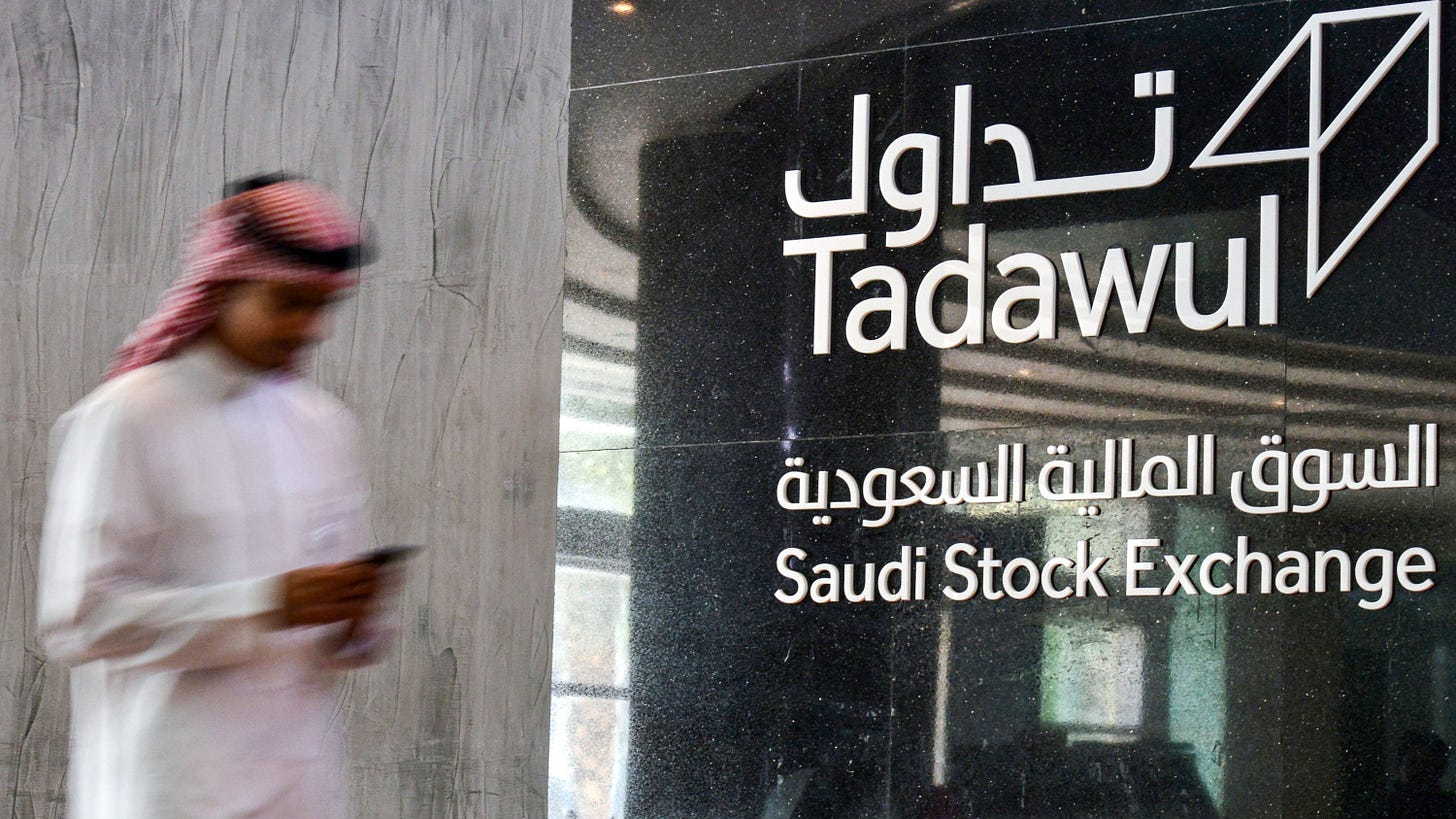Emerging Markets Daily - December 15
Putin and Xi Present United Front, Shimao Bond Collapse Sparks Contagion Fears, Inside the Misnomer of "Asia's Markets, Saudi STC Sale, Africa Vaccine Production
Geopolitics: Putin, Xi Present United Front in 90 Minute Video Call
In a thinly veiled barb at the U.S, President Xi told Putin: ‘Certain international forces are interfering in the internal affairs of China and Russia, and trampling on international law and recognized norms of international relations. China and Russia should carry out more joint actions to safeguard the security interests of both parties.’”
At Emerging World, we believe that the growing confrontation between the US and China will be the defining geopolitical issue of our era. The inherent uncertainty in this confrontation will act as a drag on emerging markets growth. Hence, the importance of this story below. Excerpts from the FT:
Financial Times
“Russian President Vladimir Putin sought to present a united front with Xi Jinping as the Kremlin said the Chinese leader supported Moscow’s demand for security guarantees that would limit western influence in its backyard.”
“In remarks shown by Russian state television at the start of their 90-minute video call on Wednesday, Putin told his ‘dear friend’ Xi that ‘a new model of co-operation between our countries has formed on principles such as non-interference in internal affairs and respecting each other’s interests’.”
“Xi, who called Putin an ‘old friend’, told him that he ‘highly appreciated’ Russia’s ‘strong support of China’s efforts to protect its key international interests’, according to the official Xinhua news agency. ‘Certain international forces are interfering in the internal affairs of China and Russia, and trampling on international law and recognised norms of international relations,’ Xi added. ‘China and Russia should carry out more joint actions to safeguard the security interests of both parties.’”
“After Putin briefed Xi on his recent demands to redraw Europe’s security order in a call with US President Joe Biden last week, the Chinese leader ‘underscored that he supports Russia’s demands for such guarantees [and] understands what concerns Russia has with regard to its western borders’, Putin’s foreign policy aide Yuri Ushakov told reporters, according to Interfax.”
“Russia sought to portray Putin and Xi’s call, the 37th meeting between them since 2013, as a show of support at a time when both countries’ relationships with the west are deteriorating to lows not seen since the cold war more than three decades ago.”
“Moscow and Beijing are not formally allied but have moved closer together since 2014, when Russia annexed the Crimean peninsula from Ukraine and fuelled a slow-burning separatist war in the eastern Donbas border region. Putin secured a major gas supply deal with China that underscored Beijing’s support for Russia in the face of US and EU sanctions over Ukraine.” Max Seddon and Tom Mitchell report.
Crash in Shimao Bonds Stokes Contagion Fear in China
Just when we thought that China had the Evergrande situation under control, a new property developer faces crisis.
“A collapse of Shimao will be far worse than Evergrande in our opinion,” said Dhiraj Bajaj, head of Asia credit at Lombard Odier. “Evergrande was known to be a highly leveraged entity, but if high quality firms across hospitality, services and development focused on high quality markets such as Shanghai can’t survive this crisis, then global confidence will be permanently lost.”
Bloomberg
“Its balance sheet is less than a third the size of China Evergrande Group’s and it doesn’t even crack the top 10 list of Chinese property companies by sales. But for many investors, Shimao Group Holdings Ltd. has suddenly become the single biggest worry in a Chinese real estate sector with no shortage of things to worry about.”
“Long considered one of the industry’s healthier players, Shimao Group had until recently appeared largely immune to the credit-market turmoil that led to defaults this month by junk-rated rivals including Evergrande and Kaisa Group Holdings Ltd. That view has changed dramatically over the past week as unconfirmed speculation of payment difficulties at Shimao Group sent the company’s bonds tumbling from nearly 90 cents on the dollar to 59 cents as of Wednesday.”
“The crash stands out because bonds of higher-rated developers have mostly weathered the selloff that sent the yield on a gauge of Chinese junk debt soaring above 20%. Shimao Group, founded by billionaire Hui Wing Mau, is still rated investment grade by Fitch Ratings, though S&P Global Ratings lowered its rating of the firm to junk last month. Many of Shimao Group’s bonds are held by investors who have much lower tolerance for defaults than those who dabble in names like Evergrande.”
“‘A collapse of Shimao will be far worse than Evergrande in our opinion,’ said Dhiraj Bajaj, head of Asia credit at Lombard Odier. ‘Evergrande was known to be a highly leveraged entity, but if high quality firms across hospitality, services and development focused on high quality markets such as Shanghai can’t survive this crisis, then global confidence will be permanently lost.’” Bloomberg reports.
There’s No Such Thing as “Asian Markets”
An important piece by Herald van der Linde, the author of “Asia’s Stock Markets: From the Ground Up,” and HSBC’s Head of Equity Strategy, Asia Pacific.
He lays out a compelling case for why we need to retire the term “Asian markets,” while demonstrating the diversity — and promises — across these multi-faceted markets.
“Rather than seeing them as one cohesive mass, it’s better to think of Asia’s stock markets as distinct groups: Mainland China and Hong Kong’s stock markets; the other East Asian markets of Korea, Japan and Taiwan; India and its Sensex index; and ASEAN's markets. These groups represent different economies and different kinds of company: one stock market may shrug off news that would cause another market to sink.”
Excerpt below:
Fortune
“When we scan our morning news feeds, we often see headlines like ‘Asian stocks follow Wall Street higher as virus fears ease” or ‘Asia-Pacific markets trade mixed as investors assess Omicron risks.’ But the term ‘Asian markets’ does an injustice to the varied nature of the region’s different stock markets. It disguises what makes these markets attractive to investors—their diversity.”
“After an eventful year for the markets—new COVID variants, supply shortages, debt crises and IPO flops, among other events—observers need to look past the shorthand of ‘Asian markets’ if they want to know how exchanges will react to future news.”
“Rather than seeing them as one cohesive mass, it’s better to think of Asia’s stock markets as distinct groups: Mainland China and Hong Kong’s stock markets; the other East Asian markets of Korea, Japan and Taiwan; India and its Sensex index; and ASEAN's markets. These groups represent different economies and different kinds of company: one stock market may shrug off news that would cause another market to sink.”
“That doesn't mean the markets are entirely independent from each other. Movement in one market may be matched in another—such as when the emergence of Evergrande's debt crisis sent Japanese shares of household appliance makers plummeting. But the reasons why these matching moves happen still depend on the structure of an individual exchange…”
“India—with its Sensex index—is a wholly different story. The Sensex is the region’s most diverse stock market, and one of its best performers over the past two decades.”
“Big names in pharmaceuticals and IT services make up a major segment of this market and so—like in Taiwan and Korea—it’s what happens in Europe and the U.S. that matters. As these players rise from obscurity to become global leaders, these stocks have performed incredibly well.”
“But alongside these behemoths are a whole cluster of Indian firms that sell everything and anything—soap, toothpaste, paint, jewelry, and everything else—in the vast local market. Most Indians live in smaller cities and towns dotted across the country, and it takes a vast distribution network to get products into these villages. The ability to overcome this huge logistics challenge—in India, each state has its own rules, regulations and bureaucracy—has allowed several of these firms to become some of Asia’s most profitable businesses.”
“This masala of local distributors and global players has allowed India’s stock market to sing its own tune. For example, 2021 was a bad year for China’s A and H markets, but a stellar one for India.” Herald van der Linde writes.
Saudi Sovereign Fund Raises $3.2 Billion from Sale of STC Stake
“The secondary public offering, the first of its kind in the Saudi Capital Market, is the largest equity capital markets transaction in the kingdom since the IPO of Saudi Aramco. It is also the largest secondary follow-on transaction in Europe, the Middle East and Africa in the past three years, and the largest secondary follow-on transaction in Central and Eastern Europe, the Middle East and Africa in about 10 years.”
The National
“Saudi Arabia’s Public Investment Fund raised $3.2 billion from the sale of a 6 per cent stake in Saudi Telecom Company, the country's largest mobile operator, through a secondary share offering.”
“The kingdom’s sovereign wealth fund sold 120 million shares to local, international institutional and retail investors at 100 riyals per share, it said in a joint statement with STC. The number of shares sold was revised from 100.2 million.”
“The secondary public offering, the first of its kind in the Saudi Capital Market, is the largest equity capital markets transaction in the kingdom since the IPO of Saudi Aramco. It is also the largest secondary follow-on transaction in Europe, the Middle East and Africa in the past three years, and the largest secondary follow-on transaction in Central and Eastern Europe, the Middle East and Africa in about 10 years.”
“The $430 billion sovereign wealth fund retains a 64 per cent stake in STC's issued shares after the offering. The free float of the telecoms operator has increased to 29.84 per cent.” Massoud A Derhally reports.
Africa Ramps Up Vaccination Production as G20 Promises Fail to Materialize
Africa Confidential
“Vaccine nationalism, supercharged by fears of the Omicron variant, pushes African countries towards local manufacturing.”
“The indefinite postponement of the World Trade Organization's meeting on a temporary waiver of the intellectual property rights on Covid vaccines, and the emergence of the Omicron variant appear to have pushed African leaders to move faster on continental production. About 7.5% of people in Africa have been vaccinated so far (AC Dispatches 24/08/21, Health activists lambast plan to export South African-bottled vaccines to Europe).”
“The African Union has announced the launch of the Partnership for African Vaccines Manufacturing (Pavm) to enable manufacturing of up to 60% of the continent's vaccine requirements by 2040, alongside 12 Covid-19 production facilities set up or in the pipeline across six African countries.”
“Kenya's President Uhuru Kenyatta has announced plans to set up a fill-finish vaccine plant known as Kenya Biovax Limited in the next six months. That push appears to have been given fresh momentum by the international response to the discovery of the Omicron variant and continued delays in vaccine delivery. The promise of direct supply agreements with Pfizer, Moderna, Johnson & Johnson, and AstraZeneca has also taken much longer to negotiate than expected.” Africa Confidential reports.
“Do not go where the path may lead, go instead where there is no path and leave a trail.” Ralph Waldo Emerson






